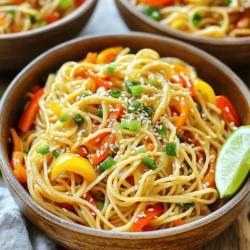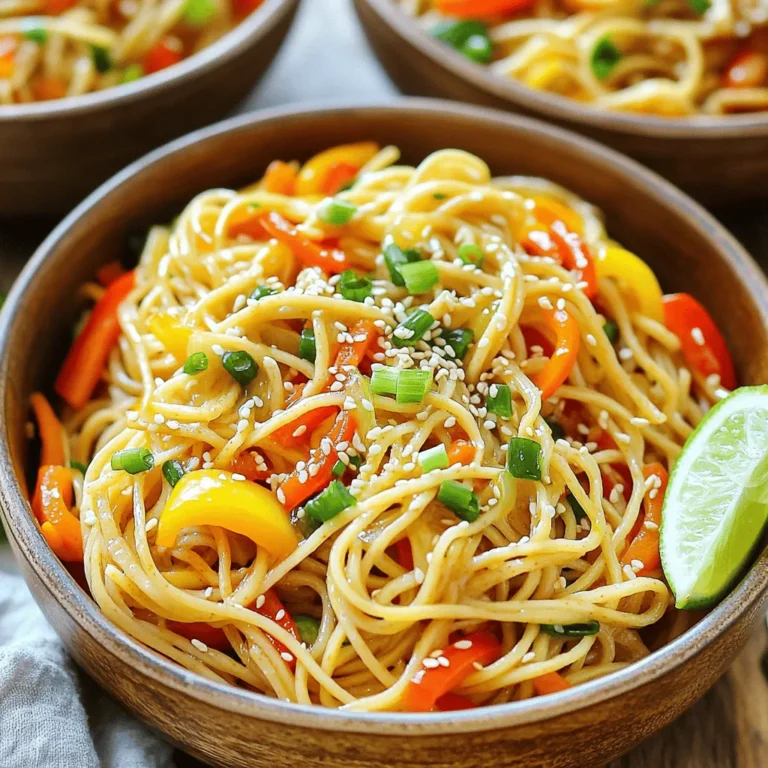Looking for a quick, tasty meal? Try my Ginger Sesame Noodles! This simple recipe bursts with flavor and is perfect for any time of day. Fresh ingredients make all the difference, so I’ll share tips for choosing the best. Plus, I’ll show you step-by-step how to cook everything perfectly. Ready to dive into a bowl of deliciousness? Let’s get started!
Ingredients
List of Ingredients
To make Ginger Sesame Noodles, gather these fresh ingredients:
– 8 oz. whole wheat noodles
– 2 tablespoons sesame oil
– 1 tablespoon fresh ginger, finely grated
– 2 cloves garlic, minced
– 1/4 cup low-sodium soy sauce
– 2 tablespoons rice vinegar
– 1 tablespoon honey or maple syrup (to taste)
– 1 cup assorted bell peppers, thinly sliced (red, yellow, and green for a colorful mix)
– 1 cup shredded carrots
– 1/2 cup green onions, finely chopped
– 1 tablespoon sesame seeds
– Salt and pepper to taste
Importance of Fresh Ingredients
Using fresh ingredients makes a big difference in flavor. Fresh ginger gives a warm, spicy kick. Fresh veggies like bell peppers and carrots add color and crunch. The taste of fresh ingredients pops in every bite. They also hold more nutrients, which boost the dish’s health. When you pick the best ingredients, your Ginger Sesame Noodles will shine.
Alternative Ingredient Options
If you can’t find an ingredient, don’t worry! Here are some swaps:
– Noodles: Use rice noodles or gluten-free pasta.
– Sesame Oil: Swap with olive oil for a milder taste.
– Honey: Maple syrup or agave nectar works well too.
– Veggies: Try broccoli or snap peas instead of bell peppers.
– Soy Sauce: Use tamari for a gluten-free option.
Feel free to get creative! Each swap can give the dish a new twist while keeping it delicious.
Step-by-Step Instructions
Cooking the Noodles
First, fill a large pot with water and boil it. Once the water is bubbling, add 8 oz. of whole wheat noodles. Cook them as the package says until they are al dente. This usually takes about 8 to 10 minutes. After cooking, drain the noodles and rinse them with cold water. This step stops the cooking and keeps them from getting mushy. Set the noodles aside in a large mixing bowl.
Preparing the Ginger Sauce
Now, let’s make the ginger sauce. Grab a medium mixing bowl. Here, combine 2 tablespoons of sesame oil, 1 tablespoon of finely grated fresh ginger, and 2 minced cloves of garlic. Next, add 1/4 cup of low-sodium soy sauce, 2 tablespoons of rice vinegar, and 1 tablespoon of honey or maple syrup. Whisk everything together until it is smooth. Set this tasty sauce aside for later.
Sautéing the Vegetables
In a large skillet or wok, heat a splash of sesame oil over medium heat. Add 1 cup of assorted thinly sliced bell peppers and 1 cup of shredded carrots. Sauté these veggies for about 3 to 4 minutes. Stir them often so they cook evenly. You want them to be tender but still a bit crisp. This keeps the dish fresh and vibrant.
Combining Noodles and Sauce
Now that the veggies are ready, it’s time to mix everything. Add the drained noodles to the skillet with the sautéed vegetables. Pour the ginger sauce over the top. Toss the mixture carefully to coat everything well. Stir for about 2 to 3 minutes until the noodles warm up and soak in the flavor.
Final Touches and Presentation
Once combined, take the skillet off the heat. Toss in 1/2 cup of finely chopped green onions. Season with salt and pepper to your taste. For a delightful crunch, sprinkle 1 tablespoon of sesame seeds on top. Serve the Ginger Sesame Noodles in individual bowls. For a fun touch, add a lime wedge for guests to squeeze over their dish. This adds a zesty kick! Enjoy your meal!
Tips & Tricks
How to Achieve Perfectly Cooked Noodles
To cook noodles just right, start with plenty of water. Use a large pot and bring it to a boil. Add salt to the water for flavor. Follow the package instructions for cooking time. Test the noodles a minute before the time ends. They should be firm but not hard. After cooking, drain them and rinse with cold water. This stops the cooking and keeps them from sticking.
Best Practices for Sautéing Vegetables
When sautéing, always heat your pan before adding oil. Use medium heat for best results. Add a splash of sesame oil first; it adds great flavor. Then, add your vegetables. Stir them often to cook evenly. Keep an eye on the time; you want them tender yet crisp. If they start to brown too fast, lower the heat. This keeps their bright color and crunch.
Making Ahead of Time: Storage and Reheating Tips
You can make Ginger Sesame Noodles ahead of time. Store them in an airtight container in the fridge. They last up to three days. When reheating, add a splash of water or extra sauce. This keeps the noodles moist. Heat them in a skillet over medium heat, stirring gently. This method warms them without making them mushy. You can also use a microwave, but be careful not to overcook.

Variations
Gluten-Free Substitutes
If you need gluten-free noodles, try rice noodles or quinoa noodles. These options work well and maintain great flavor. Look for gluten-free soy sauce too. It’s easy to find, and it keeps the dish tasty.
Adding Protein: Chicken, Tofu, or Shrimp
To make Ginger Sesame Noodles heartier, add protein. Cooked chicken breast works nicely. Just slice it thin and toss it in. For a plant-based option, use firm tofu. Press it, cube it, and sauté until golden. Shrimp is another great choice. Cook them quickly until they turn pink. Each protein adds its unique twist to the dish.
Vegetable Variations: Seasonal Ingredients
Feel free to mix in seasonal veggies. Broccoli and snap peas are great in spring. Try zucchini or asparagus in summer. In fall, add roasted squash or Brussels sprouts. This keeps the dish fresh and fun. Use whatever you enjoy or have on hand for a personal touch.
Storage Info
How to Store Leftovers
To store leftover Ginger Sesame Noodles, let them cool first. Once cooled, place them in an airtight container. This keeps the noodles fresh. You can store them in the fridge for up to three days. Make sure to label the container with the date. This will help you keep track of their freshness.
Freezing Ginger Sesame Noodles
You can freeze Ginger Sesame Noodles for later use. First, cool them completely. Then, portion the noodles into freezer bags. Press out as much air as you can before sealing the bags. Label the bags with the date. They can last in the freezer for about three months. When you’re ready to eat, thaw them in the fridge overnight.
Shelf Life and Reheating Suggestions
Ginger Sesame Noodles stay good in the fridge for up to three days. To reheat, simply place them in a pan over medium heat. Add a splash of water or extra sesame oil to prevent sticking. Stir often until heated through. You can also microwave them in a bowl. Cover the bowl with a damp paper towel to keep them moist while reheating. Enjoy your tasty meal again!
FAQs
Can I use different types of noodles?
Yes, you can use different noodles. Try rice noodles, egg noodles, or udon. Each type gives a unique taste and texture. I prefer whole wheat noodles for their health benefits and nutty flavor.
What is the origin of Ginger Sesame Noodles?
Ginger sesame noodles have roots in Asian cuisine. They blend flavors from China and Japan. These noodles highlight ginger and sesame, two common ingredients in many Asian dishes.
Are Ginger Sesame Noodles healthy?
Yes, they can be healthy! Whole wheat noodles add fiber. Fresh veggies like bell peppers and carrots boost vitamins. Use low-sodium soy sauce to keep sodium in check.
Can I make this dish vegan?
Absolutely! To make it vegan, just swap honey for maple syrup. The rest of the ingredients are already plant-based. This way, everyone can enjoy the dish.
What can I serve with Ginger Sesame Noodles?
You can serve Ginger Sesame Noodles with various sides. Try steamed broccoli, sautéed greens, or a fresh salad. They also pair well with grilled chicken or tofu for extra protein.
In this blog post, we explored the key ingredients for making Ginger Sesame Noodles. Fresh ingredients enhance flavor and quality. We also discussed cooking techniques and offered creative variations to suit your taste. Remember, you can prepare these noodles ahead of time for easy meals. With the right storage, leftovers can still taste great. Try using different proteins or veggies to make each dish unique. Enjoy your cooking, and let the flavors shine!


